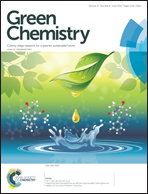Fractionation of lignocellulosic biomass using the OrganoCat process
Abstract
The fractionation of lignocellulose in its three main components, hemicellulose, lignin and cellulose pulp can be achieved in a biphasic system comprising water and bio-based 2-methyltetrahydrofuran (2-MeTHF) as solvents and oxalic acid as catalyst at mild temperatures (up to 140 °C). This so-called OrganoCat concept relies on selective hemicellulose depolymerization to form an aqueous stream of the corresponding carbohydrates, whereas solid cellulose pulp remains suspended and the disentangled lignin is to a large extent extracted in situ with the organic phase. In the present paper, it is demonstrated that biomass loadings of 100 g L−1 can be efficiently fractionated within 3 h whereby the mild conditions assure that no significant amounts of by-products (e.g. furans) are formed. Removing the solid pulp by filtration allows to re-use the water and organic phase without product separation in repetitive batch mode. In this way, (at least) 400 g L−1 biomass can be processed in 4 cycles, leading to greatly improved biomass-to-catalyst and biomass-to-solvent ratios. Economic analysis of the process reveals that the improved biomass loading significantly reduces capital and energy costs in the solvent recycle, indicating the importance of process integration for potential implementation. The procedure was successfully scaled-up from the screening on bench scale to 3 L reactor. The feedstock flexibility was assessed for biomasses containing moderate-to-high hemicellulose content.


 Please wait while we load your content...
Please wait while we load your content...